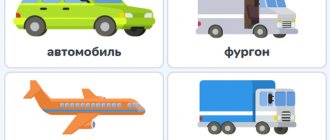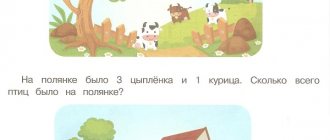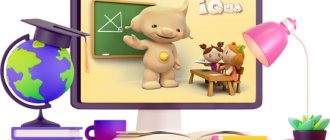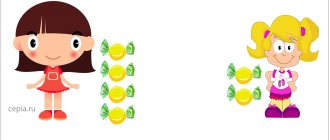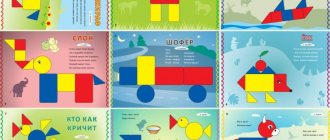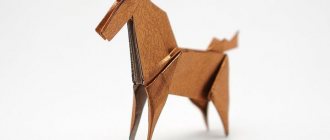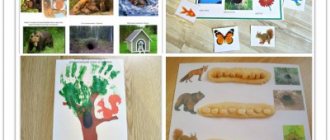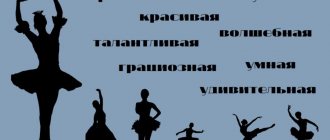Logic puzzles for preschoolers 5-6 years old (for attentiveness, memory development)
10 interesting and exciting tasks for preschoolers. Source: www.liveinternet.ru
Task 1: Katya, Galya and Olya drew heroes from the village of Prostokvashino: Pechkin, Sharik and Matroskin. Who drew who, if Katya didn’t draw Pechkin and Sharik, and Galya didn’t draw Pechkin?
Task 2: There is a maple tree. There are two branches on the maple tree, on each branch there are two cherries. How many cherries are there in total?
Problem 3: If a goose stands on two legs, then it weighs 4 kg. How much will a goose weigh if it stands on one leg?
Problem 4: Two sisters have one brother each. How many children are in the family?
Problem 5: A giraffe, a crocodile and a hippopotamus lived in different houses. The giraffe did not live in a red or blue house. The crocodile did not live in a red or orange house. Guess which houses the animals lived in?
Problem 6: Once upon a time there were three girls: Tanya, Lena and Dasha. Tanya is taller than Lena, Lena is taller than Dasha. Which girl is the tallest and which is the shortest? What is the name of which one?
Problem 7: Misha has three carts of different colors: red, yellow and blue. Misha also has three toys: a tumbler, a pyramid and a spinning top. In the red cart he will not carry a spinning top or a pyramid. The yellow one is not a spinning top or a tumbler. What will Misha carry in each of the carts?
Problem 8: The dragonfly is not sitting on a flower or on a leaf. The grasshopper does not sit on a fungus or on a flower. The ladybug is not sitting on a leaf or on a fungus. Who is sitting on what? (It’s better to draw everything.)
Problem 9: Alyosha, Sasha and Misha live on different floors. Alyosha lives neither on the top floor nor on the bottom. Sasha lives neither on the middle floor nor on the bottom. On what floor does each boy live?
Problem 10: Three plates contain different fruits. The bananas are not in a blue or an orange plate. Oranges are not in a blue or pink plate. What plate are the plums in? What about bananas and oranges?
Colorful boats
I came to the river. How many colorful boats are on the river today: yellow, red, orange! They all arrived here by air. A boat will arrive, land on the water and immediately sail away. Many more will arrive today, and tomorrow, and the day after tomorrow. And then the ships will no longer arrive, and the river will freeze. Tell us what kind of boats these are and what time of year they appear.
N.F. Vinogradova
For whom did Vitalik leave the rowan tree?
Vitalik and his mother were walking through the forest. Vitalik saw a rowan bush strewn with berries and called his mother. Together they picked a full basket of berries. “Mom, why did you leave the berries on the branches? If you collect everything, the basket will be full!” “You don’t need to pick all the mushrooms and berries in the forest, you need to leave a few,” my mother said and explained why. What did the mother tell her son?
N.F. Vinogradova
What is the bear looking for?
Look at the clubfoot! He can barely toss and turn. He gorged himself on fish and berries in the summer, and now he’s wandering through the forest, scaring the little animals and looking for something, looking for something... What is the bear looking for?
I.A. Panichev
What kind of animal?
You won't understand this animal. He either sleeps or runs. He wakes up, stretches, cracks nuts, eats dried berries - and curls up into a ball again. Dark, warm. And it makes no difference to him - day or night. What kind of animal is this?
I.A. Panichev
Something white rolled out into the clearing: long ears, slanted eyes, looking to the sides. Jump-jump and out of sight under a bush. Look how I shuddered! Don't be afraid - it was the frost that cracked the branch. No, he runs away... and even confuses his tracks! Who it?
I.A. Panichev
Why do fawns run away?
When the snow began to melt, the reindeer had little fawns. It turns out that at first they are very weak, powerless and trembling all the time. It is especially alarming to see how their legs are trembling, it seems that they are about to break, and the kids will fall into the snow.
When the fawns were very small, they allowed themselves to be stroked on the forehead. And now, as soon as you approach them, they run away. Why do fawns run away?
CM. Olefir
What happened here?
One day at the end of April, lumberjacks noticed a nest with a nutcracker hiding in it. They surrounded the nest, stroked the bird's feathers, treated it to sausage and nuts - the nutcracker did not even move. And soon there were already six nutcrackers flying around the clearing. All colorful, all loud. What happened here?
CM. Olefir
What happens in May?
In the North it can be warm in March, in April the sun doesn’t want to leave the sky, and in May... What happens in May?
CM. Olefir
Speech logical tasks for children 5-6 YEARS OLD
What month is it?
The northern summer quickly passed. The sky frowned, and suddenly, instead of the expected rain, large snowflakes began to swirl. The gray forest has calmed down. The last leaves tremble from gusts of strong wind. Only the stubborn alder does not give in, it does not want to turn yellow. What month is it?
I.A. Panichev
What did the bear say?
Everyone prepares for winter in their own way. A fidgety squirrel is jumping. He collects nuts, places them in hollows, in wood crevices, and if he finds a fungus on the ground, he picks it and hangs it on a tree to dry - this will be very useful in winter. The squirrel works all day and all day long looks at its bear neighbor, who has become lazy and clumsy since the fall. “Why are you so lazy, bear? - asks the squirrel. — Why don’t you prepare for winter and stock up on food? There will be nothing to eat in winter.” The bear laughed and said something quietly to the squirrel, so quietly that she didn’t hear it. What did the bear say to the squirrel? Why did you laugh when you heard her question?
N.F. Vinogradova
Where do birds spend the night?
Many people think that the nest serves as a home for the bird. But when someone says that a small or large bird took refuge from the weather in its nest, know that this is not true. After hatching the chicks, the female leaves the nest and never returns to it. Birds have no home.
Where do they spend the night?
I.A. Panichev
What does a seagull eat?
As if on a watchtower, seagulls stand on a stone, looking out for prey. Yellow beak, dazzling white chest. Only the back and wings are light gray. Keen eyes immediately notice what they can profit from. What do seagulls eat?
Who is this man?
A man was walking through the taiga. I came across a stream. He sat down next to it, carefully examined the water, and tasted it. He was very interested: why is the water such a red color? You and I will walk through - well, stream and stream, what's special about it? And the stream will tell this person a lot. If the water is gray, it means there is fertile land, black soil. And if it’s yellow, then there’s clay underneath. But if the water is rusty and red in color, then there may be iron deposits underground. Who is this man?
A.F. Members
Logical problems in mathematics for ingenuity and ingenuity with answers
AWARENESS TASKS
- There were 9 steamships at sea. 2 ships docked at the pier. How many ships are there at sea? (9 ships.)
- There were 7 brothers walking, each brother had one sister. How many people walked? (8 people).
- What kind of dishes can you not eat anything from? (From empty.)
- The animal has 2 right legs, 2 left legs, 2 legs in front, 2 in back. How many legs does an animal have? (4 legs.)
- 9 sharks were swimming in the sea. They saw a school of fish and dived deep. How many sharks swam in the sea? (9 sharks, only they dived.)
- The vase contains 3 tulips and 7 daffodils. How many tulips are there in a vase? (There were 3 tulips in the vase.)
- 7 boys cleared one path in the garden. How many paths did the boys clear? (7 tracks.)
- 2 brothers each drew 2 drawings as a gift to their grandfather. How many drawings did grandfather receive? (4 pictures.)
- The grandmother knitted scarves and mittens for her grandchildren. In total she knitted 3 scarves and 6 mittens. How many grandchildren did your grandmother have? (3 grandchildren - explain the answer.)
- Grandfather, grandmother, granddaughter, Bug, cat and mouse pulled and pulled and finally pulled out the turnip. How many eyes saw the turnip? (12 eyes.)
Children collected an autumn bouquet in the park. It contained 5 maple, 4 birch, 2 oak, 1 aspen leaves. How many different trees did the bouquet come from? (From 4 trees.)
logicheskie_zadachi
Logic for children 5 - 7 years old
This manual contains very interesting tasks, assignments, exercises and games for the development of logical thinking in preschool children, aimed at comparing objects according to various criteria, highlighting significant differences between objects, generalization and classification. This book is recommended for use in kindergartens and at home for children to study together with their parents. This manual can be used to prepare for mathematics lessons at school.
Download the manual by Tikhomirova L.F. Logics. Children 5-7 years old in pdf format
Fourth wheel
Ask your child what is unnecessary, then ask them to justify it. For example:
- sundress, shirt, boots, fur coat (boots - shoes);
- cabbage, plum, eggplant, beet (plum is a fruit);
- pig, wolf, fox, deer (pig is a domestic animal);
- chest of drawers, cabinet, wardrobe, sofa (sofa - upholstered furniture).
In this case, more complex categories are again used than at the previous stage, since the child must know more about the world around him.
Concept of logical thinking
Logical thinking is a physiological process as a result of which a person comes to conclusions based on evidence and prudence.
There are three types of logical judgments.
- Abstract judgment. A person builds conjectures on concepts and properties that cannot be felt. They are not valid, they are in the abstraction.
- Figurative judgment. A person uses his imagination and imagines specific images that occur in life.
- Verbal judgment. People often share their opinions with others. During the conversation, mental analysis occurs, leading to specific conclusions.
Logical thinking begins to develop at an early age. The stages of formation of thinking in the process of child growth will be discussed further.
Analogies and Antonyms
Analogies help to update your vocabulary and find logical connections between words:
- the fork is for eating, and the knife is for…(cutting);
- boots are shoes, and shorts are...(clothing);
- It’s cold in winter, and ... (warm) in summer, etc.
Antonyms:
- thick – thin;
- cold - warm;
- harmful - useful;
- evil - good, etc.
These words and phrases are given as an example; you can come up with something of your own, but you need to select them depending on the child’s individual level of knowledge.
Finding errors and inconsistencies
These tasks are an excellent tool for training attention and it is not important that the child learns not to immediately take the information received on faith, but to think for a while.
For such tasks, you can use fable pictures (for non-speakers) or in the form of fable poems, for example:
- Sasha ate soup, so he is hungry;
- Ilona couldn’t come home, so she forgot her keys, etc.
By the way, such tasks are very useful for correcting agrammatisms and developing a full understanding of speech.
How to develop visual-figurative thinking?
In this case, various games and exercises will come to the rescue.
The most effective way to develop visual-figurative thinking is activity that allows you to translate your plans into reality. For kids, this is, first of all, any types of construction and all kinds of didactic games aimed at developing thinking and imagination. Let us consider in more detail the techniques that promote the development of imaginative thinking.
The formation and development of visual-figurative thinking is facilitated by:
- passing labyrinths;
- tangram game;
- unfinished drawings;
- solving a Rubik's cube;
- tasks to find absurdities;
- solving puzzles and riddles;
- tasks to find and restore the missing element;
- design;
- exercises to develop interhemispheric connections;
- reading with further analysis of the characters of the main characters;
- exercises aimed at developing creative imagination;
- comparison exercises, search for differences;
- using games with rearranging sticks (matches);
- solving droodles;
- compiling stories or fairy tales based on a given beginning, or, conversely, inventing the ending of a story;
- describing an object from memory;
- retelling what you read;
- exercises with inventing associations.
Remember how in the poem by Yu. Moritz “What is it like?”
A willow is rustling on the mountain, A bee is ringing on a willow, Striped like a zebra.
Sometimes water fills our boat, A star swims in the depths, Silver like a fish.
There are maples and oaks in the grove, And under them there are mushrooms, Each mushroom looks like an umbrella.
A young month has come out, The sky seems like water, A cloud seems like a wave , The moon looks like a wooden boat.
How similar everything is! So, I probably look like someone too!
I went and shouted to the goats, ducks, sheep and dragonflies: - Who do I look like?
The white goat turned, smiled like a goat, and said like a human: “Don’t you see for yourself?”
You are kinder than a calf, More cheerful than a kid, You are still just a child, But you look like a person!
Thus, the ability to imagine objects in the mind, move them, and perform various manipulations are the most important means of developing a child’s abilities and his mental activity. Developed visual-figurative thinking can be compared to the foundation of all mental activity of a child.
Even in the works of Aristotle, the importance of developing this type of thinking was noted. Creating a mental image helps a person to be result-oriented, strive to achieve what is planned, control his own actions and anticipate their consequences. It helps to activate the creative potential inherent in every person. Anyone who has developed visual-figurative thinking is able to think and remember information much faster.
Therefore, even in preschool age, it is necessary to develop the child’s visual and figurative thinking using the above techniques, and you can also train figurative thinking with special exercises.
